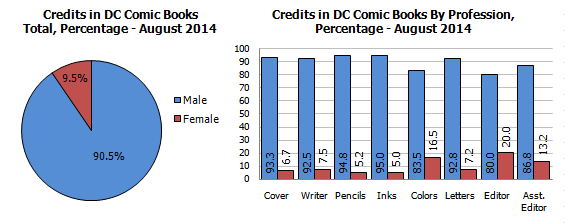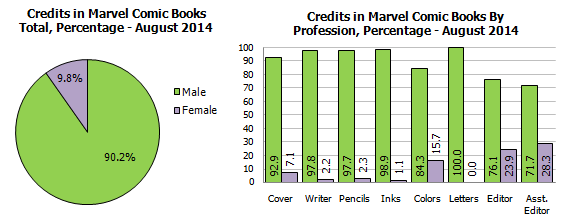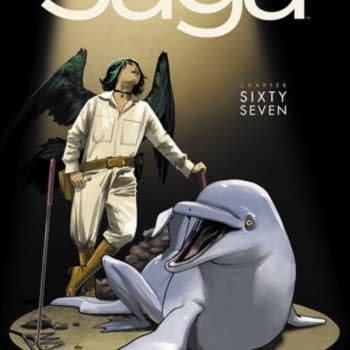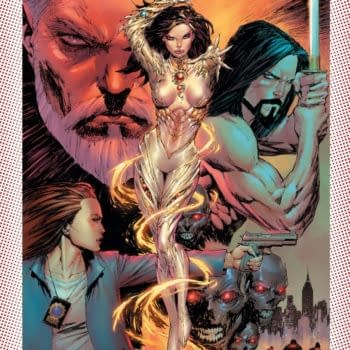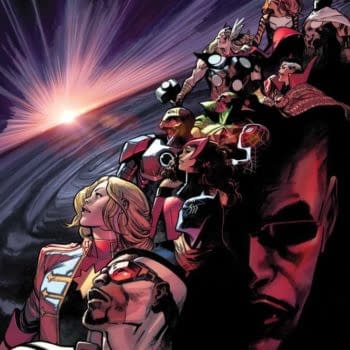Posted in: Comics, Recent Updates | Tagged: Comics, dc, dc comics, entertainment, gendercrunching, katie kubert, marvel, Marvel Comics, variant covers, women in comics
Gendercrunching August 2014 – The Big Two Fall From August Last Year But Variant Covers Show Some Developments
By Tim Hanley
The overall percentage of female creators at DC and Marvel dropped in August, resulting in one of the lowest combined totals since this project began more than three years ago, with both publishers in single digits. We also take a look at variant covers, and how they affect the overall numbers.
DC COMICS
August wasn't terrible for DC on the creative side of the charts, but the low editorial numbers continue to bring down their overall total. In August 2014, DC Comics put out 77 new comics featuring 692 credited creators, 626 men and 66 women. Here are their numbers:
DC fell 1.4% overall, which is a significant drop given the low percentages we're dealing with here. Pencillers, inkers, colorists, and letterers all rose from their July totals, with colorists gaining a substantial 5%. While cover artists, writers, and assistant editors fell a couple of percentage points, the biggest drop was with editors, who fell a whopping 10.5%. DC seems to be doing a bit of editorial reshuffling, and the loss of Katie Kubert editing the weekly Batman Eternal hit the book in the second week of August. The solicits show that DC is poised to do rather well on the creative side this fall, but these small editorial numbers may continue to drag down their overall average.
Compared To A Year Ago: Last August, DC had 12% female creators overall, so they're down 2.5% since then.
MARVEL COMICS
The high profile categories were a weak spot for Marvel this month, despite some decent numbers elsewhere. In August 2014, Marvel released 76 new comic books with 605 credited creators, 546 men and 59 women. Let's look at the stats:
A 1.3% drop overall is a notable slide, and Marvel was down from, or equal to, their July totals in every category but one. Only editors rose, and by just 1%. Everything else feel by a percentage point or two except for letterers, who remained steady at 0% for the 43rd straight month. Marvel's numbers were all very low; paltry for big name categories like writers, pencillers, and inkers, and below average in what used to be the stronghold of editorial. Marvel's dropped significantly this year, as will become clear in the following comparison.
Compared To A Year Ago: Marvel was at 14.1% female creators last August, and have fallen 4.3% since then.
VARIANT COVERS
Variant covers are back. Once derided as a marketing gimmick that ruined the comic book market, now they are standard practice at both major superhero publishers. Throughout 2014, DC Comics has had a different variant theme each month, with usually at least 20 of their titles participating. They also do variant covers for the first few issues of new series. Marvel has variant themes as well, though they are less expansive than DC's. Their new series variant practices are massive, however; a first issue of a new Marvel book usually has anywhere from 2-5 variant covers along with the standard cover, and continue with at least one variant for upwards of five issues.
With both publishers putting out 20-30 variant covers a month, I thought it would be interesting to see how the variants affect the overall percentage of female creators at DC and Marvel. I looked back at the past three months of data and separated out the variant covers to see how their numbers compared to the full cover totals you see here each month. The following chart shows the percentage of female creators on variant covers for June, July, and August, along with the average of these three months (AVERAGE) and the average of the full cover totals for the same three month span (REGULAR). DC is red, Marvel is purple. Let's take a look:
Let's begin with the obvious: It's never a great sign when I build a chart and it only goes as high as 15%. These numbers aren't huge. But there are positives for both publishers. At DC, their "Bombshell" variants gave them their best month for female artist representation in June, with the "Batman 75th Anniversary" variants in July being the lowest; August's "Selfie" variants were in the middle. Their average for these three months was in double digits, which is a notable feat for any category on the creative side of things, and the average was in the ballpark of their past few months of overall totals.
DC's average for their variants is also higher than the average of all of their covers combined, and by a significant margin. This means that the variant covers are actually helping to improve DC's overall percentage of female creators. Without the variants, the cover numbers would drop lower and bring down the total. Now, they're not a huge influence on the numbers. We're talking tenths of a percentage point at best. But some benefit, however small, is a positive bit of news, and that's rare when you're talking women in comics stats.
Marvel's variant numbers had some stark differences month to month, with a big decrease from June to August, and the average came out to only 8.6%. Their variant total is lower than DC's, though again we aren't talking huge numbers here with either publisher. But on the plus side, their variant cover average and their overall cover average came out to be exactly the same. Thus, while their variant covers don't increase their overall percentage of female creators, they don't bring them down at all either. Be they variant or standard covers, Marvel is hiring female creators to draw and color them at the same, albeit low, rate.
So the effect of variant covers on the overall total percentage of female creators ranges from none to slightly positive at the Big Two. Granted, these are pretty tame results, but when the number of female creators are so low, as they clearly were at DC and Marvel in August, we should investigate potential reasons why. Now we know that variant covers are not a contributing factor in the lack of women working at the Big Two. They could easily be hiring a lot more women to do their variant covers, but their current variant practices are not a drain on their numbers.
To learn more about this statistics project and its methodology click here, and to see the previous stats click here. You can visit Tim at Straitened Circumstances and follow him on Twitter @timhanley01. His book Wonder Woman Unbound: The Curious History of the World's Most Famous Heroine is available now.


